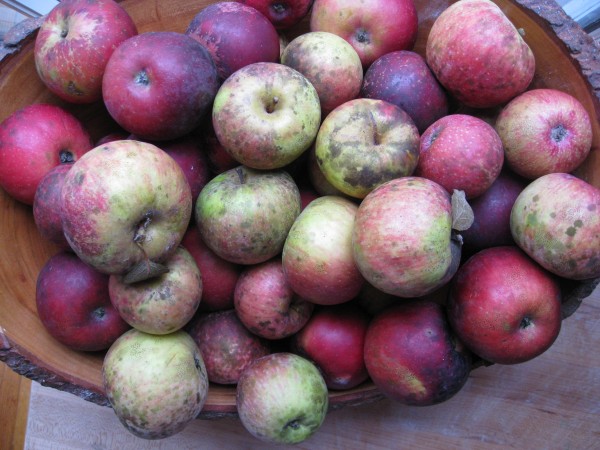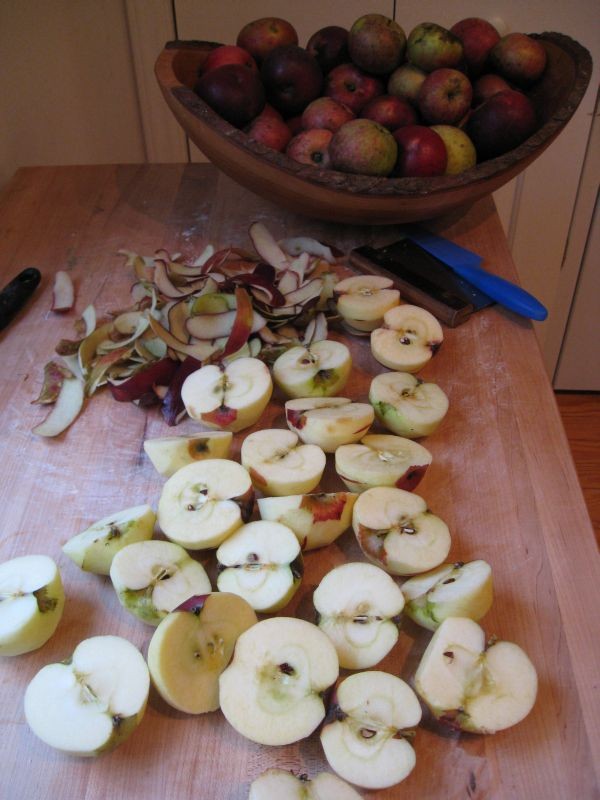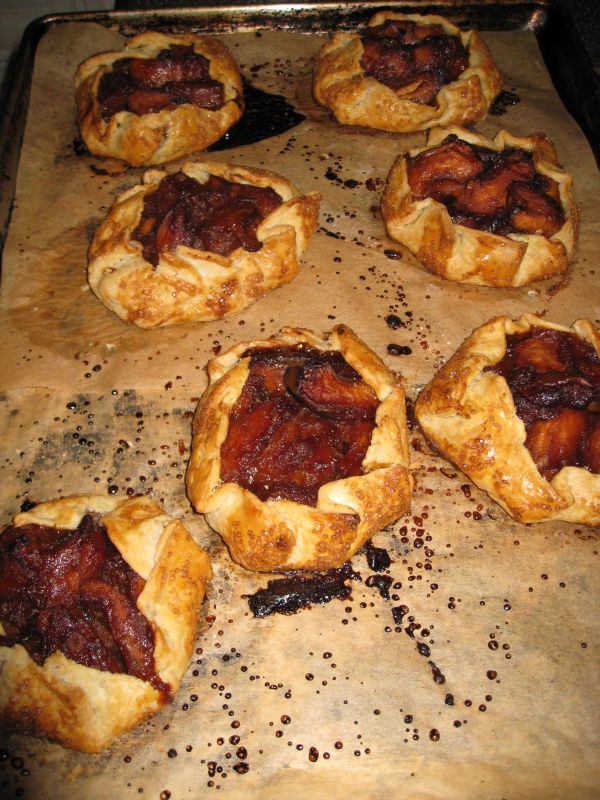 One lovely evening a couple of weeks ago, I watched the documentary Food Fight in an outdoor theater in my downtown. The documentary focuses on how the 1960s counterculture — specifically the Berkeley crew of which Alice Waters was a member — led to the current sustainable agriculture boom. The documentary champions the sensual pleasures and health promotion of fresh, locally grown food, but I couldn’t help noticing one glaring omission.
One lovely evening a couple of weeks ago, I watched the documentary Food Fight in an outdoor theater in my downtown. The documentary focuses on how the 1960s counterculture — specifically the Berkeley crew of which Alice Waters was a member — led to the current sustainable agriculture boom. The documentary champions the sensual pleasures and health promotion of fresh, locally grown food, but I couldn’t help noticing one glaring omission.
In my personal experience the single most rewarding aspect of eating locally has been exploring my own region in depth. I think of it as seeking the wisdom of Wendell Berry who says repeatedly, “You’ve got to know where you are. You’ve got to consult the genius of the place.”
Before moving to North Carolina, I was living a few miles from where my family had settled six generations back. The loss that I felt in my new place was a disconnection to the past and to the land that I now lived on. I fell into a counterculture of my own — a community of multigenerational farmers and DIY punks who mostly grew and/or ate seasonal, locally grown and foraged food. There was an intentional effort within this community to live Berry’s idea of a good life, one that values sustainable agriculture, healthy rural communities, connection to place, the pleasures of good food, meaningful work, a functioning local economy, reverence for nature and the interconnectedness of life.
 I experienced an ever increasing awareness that the food choices I made were governed by the competing considerations of identity, convenience, price, and responsibility. Through my choice to support small, local farmers by buying directly from them, I could help preserve agricultural land in an area that was experiencing rapid growth.
I experienced an ever increasing awareness that the food choices I made were governed by the competing considerations of identity, convenience, price, and responsibility. Through my choice to support small, local farmers by buying directly from them, I could help preserve agricultural land in an area that was experiencing rapid growth.
In the long term, however, what keeps me interested in locally grown food is discovering that self-imposed geographical limits on our foodshed support the minor agricultural products, for which there are increasingly fewer markets in our current boundless global food society. There is a deep and understated sort of satisfaction that comes from delving into long forsaken traditional foods, such as lard from pastured pigs as a cooking fat, sorghum molasses as a wholesome sweetener, and old varieties of Southern apples found here in the North Carolina Piedmont.
It was in this spirit of discovery that I first sampled a rustic, idiosyncratic apple that I found for sale at the Carrboro Farmer’s Market. That apple had a winey, complex taste that just doesn’t exist in modern apple varieties. I sought to learn more. It turns out that although they are virtually extinct on the commercial market, there are many, many varieties of delicious old timey apples with a rich, if disappearing, history behind them. And that is what fascinates me: not just a local apple, but an apple with a story, a history, and a sense of place, all of which contribute to the pleasure of every winey bite.
 My apple love led me to premier apple preservationist Creighton Lee Calhoun, who grows 450 varieties of heirloom apples at his nursery and apple orchard just down the road from me in Chatham County, North Carolina. In his book, Old Southern Apples, he describes over 1600 beloved Southern apple varieties, many of which are now extinct. The reason that so many different varieties arose is that European settlers opened enormous new lands all over the South from the 17th to late 19th century. There were perhaps tens of millions of apples seeds planted — not grafted as in the common nursery practice — in the South during this time. Apple seeds are like humans — each has a unique genetic code and will yield a tree that is different from its parent tree.
My apple love led me to premier apple preservationist Creighton Lee Calhoun, who grows 450 varieties of heirloom apples at his nursery and apple orchard just down the road from me in Chatham County, North Carolina. In his book, Old Southern Apples, he describes over 1600 beloved Southern apple varieties, many of which are now extinct. The reason that so many different varieties arose is that European settlers opened enormous new lands all over the South from the 17th to late 19th century. There were perhaps tens of millions of apples seeds planted — not grafted as in the common nursery practice — in the South during this time. Apple seeds are like humans — each has a unique genetic code and will yield a tree that is different from its parent tree.
Apple seeds were cheap, durable and portable, and the men and women who planted these trees knew that most seeds would yield mediocre apples at best. Most apples would be used to feed the hogs or to make vinegar or hard cider. A few of the seedlings would yield apples good enough for cooking, fresh eating, and some to keep through the winter. Out of the millions of seeds that were planted, a few would become exceptional trees that were cherished by Southerners. These trees were often reproduced by digging up the root sprouts that sometimes spring up around the apple tree. It is those varieties that have survived in the backyards of the old homesteads that Calhoun has collected.
Thanks to his propagation, those storied apples can be found for sale at my local farmer’s market and all of my apple recipes are better for it.
Heirloom Apple Sauce (makes about 5 half pints)
2 cups water
2 cups apple juice
1 cup orange juice
6 Tablespoons sugar or honey
6 whole cloves
4 cardamom pods, cracked
2 cinnamon sticks
1/2 teaspoon of fennel seeds
About 10-12 medium apples, preferably sweet and soft fleshed varieties, peeled, cored, and quartered (if you have a food mill, you can skip the peeling and coring)
1 teaspoon vanilla extract
In a medium saucepan, combine the water, apple juice, orange juice, cloves, sugar, cardamom, cinnamon, and fennel. Bring to a boil and reduce liquid by half. Strain the liquid to remove the spices.
In a large heavy bottomed saucepan, combine the apples with the spiced liquid. Simmer for about 20 minutes until the apples are falling apart tender. Remove the apples from heat, add vanilla, and let cool. Process in a food processor or food mill to desired consistency. Ladle into sterilized jars and top with two-piece lids. Process in a water bath for 15 minutes.
Oven-Roasted Apple Butter (makes about 4 half pints)
To turn your applesauce into apple butter,
Preheat oven to 350 degrees F.
To your applesauce mixture, add ½ cup brown sugar, 1 Tablespoon of ground cinnamon, and ½ teaspoon each of ground cloves and ground ginger. Bake the apple puree, stirring occasionally, for 1 1/2 to 1 3/4 hours, or until very thick and deeply browned.
Ladle the apple butter into sterilized jars, top with two piece lids and process in a water bath for 10 minutes.
 Apple tartsRustic Apple Tarts (makes 1 large tart or 6 small tarts)
Apple tartsRustic Apple Tarts (makes 1 large tart or 6 small tarts)
Dough
½ pound butter, unsalted, very cold and cut into 1-inch pieces
½ cup ice water, drained
¾ teaspoon salt
2 ½ cups unbleached all purpose flour
Apples
About 10 medium apples, preferably a sweet-tart cooking variety, peeled, cored, and cut into wedges, about 8 per apple
½ cup sugar
1 tablespoon butter
Splash of apple cider or juice
Pinch of salt
¼ cup crème fraiche, optional
Walnuts, optional
Measure flour and salt in a bowl or in the bowl of a food processor. Toss in the cubes of butter. Using a pastry blender or pulsing your food processor, cut the butter in the flour until the butter is the size of large peas. You want fairly large pieces of butter because this is what produces a flaky crust. Pour all of the water into your flour mixture and mix the dough until you can gather it into a shaggy ball. Flatten the ball of dough slightly and fold it back on itself to get it to come together more. Flatten the dough into a disc, wrap in plastic wrap and refrigerate at least 1 hour before rolling out.
Place the disc of dough on a well floured surface. Flour the top of the dough and brush off the excess. Flour your rolling pin as well. Place your rolling pin in the center of the disc of dough and roll towards the top. Turn the dough a quarter turn to your right and repeat. Use your bench scraper or a spatula to scrape the bottom of the disc of dough to keep it from sticking. Add more flour as necessary. Continue to flour your rolling pin and scrape any sticky pieces of dough off of it frequently. When your dough is ¼-inch thick and in a rough circle, drape it over your rolling pin and transfer it to a parchment lined baking sheet. Cover it with plastic wrap and place it in the refrigerator while you prepare your apples.
To caramelize the apples, place a large frying pan over medium heat. Sprinkle the bottom of it with ¼ cup of sugar. When the sugar begins to caramelize, swirl the pan and toss in about ½ of the apple slices. Toss the apples to coat them in caramel and let them cook for about 2 minutes. Dump them out on a parchment lined baking tray and spread them out slightly to cool. Cook the other half of the apples exactly the same way. When you dump the second batch of apples onto your baking tray, place the pan back over medium heat and add the tablespoon of butter, the apple juice and a pinch of salt. Bring to a boil and with a wooden spoon try to get any bits of caramel stuck to the pan stirred into the sauce and melted. Pour this over the apples and set aside.
Remove the tart dough from the refrigerator. If you wish, brush the bottom of the dough with crème fraiche. Pile the apples into the center of the tart, leaving about a three inch border. Fold the border up over the apples. Brush the crust with an egg glaze (1 egg beaten with a pinch of salt and a splash of cream) and sprinkle it lightly with sugar.
Bake at 375 degrees until deep golden brown, about 1 hour.
Alternately, you can make 6 smaller tarts. Just reduce the cooking time to about 40-45 minutes.



